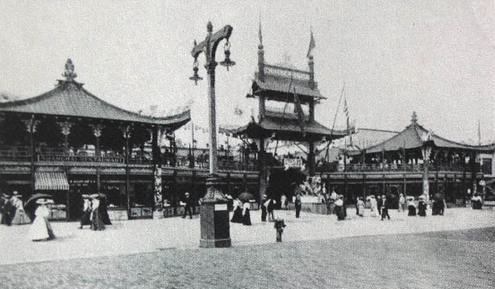| China at the World Expo
By staff reporter QIAO TIANBI
A good variety of industrial, agricultural and handicraft products from China appeared at the first World Expo in London in 1851. Silk sent by a Guangdong merchant living in Shanghai won both the gold and silver prizes. The man, Xu Rongcun, got news of the expo from British diplomats and businesspeople in Shanghai, and shipped 12 packages of Yung Kee silk from his store. Due to the coarse packaging, the fine material was neglected for several months, but was immediately loved once opened. The queen personally handed the gold and silver medals and certificates to Xu Rongcun. Orders from both home and abroad soon flooded into his store.
 |
|
The China Village at the 1904 St. Louis World Expo. |
During the 1889 World Expo in Paris, a group of Chinese officials who didn't know any foreign languages and had never left China before visited the Eiffel Tower in the company of Chinese councilor Chen Jitong. The tower was a landmark of the expo, while the machinery hall showcased the latest technical achievements of the age. The group also went up in a hot air balloon.
In the early 20th century China's presence at the World Expo was manipulated by foreigners who took charge of Chinese customs under colonial treaties forced on the decrepit feudal regime. Motivated by economic interests, these people often painted China in a negative light. For instance, the 1904 Expo in St. Louis featured a group of clay sculptures depicting Chinese prostitutes, beggars, prisoners and opium addicts. This practice didn't change until the Milan Expo in 1906, when China organized participation by its officials and citizens without the meddling of foreign forces.
The People's Republic of China made its debut at the World Expo in 1982 in Knoxville. The China Pavilion, with a resplendent display comprising ten bricks from the Great Wall, the terracotta warriors and bronze chariots of Emperor Qinshihuang's tomb and other national treasures, received 30,000 visitors every day, almost one-fourth of the total number visiting the expo. Local media exclaimed that Americans were mesmerized by the old bricks of China's Great Wall. By the 2005 expo in Aichi, China had participated in 11 World Expos and all registered international expositions. Its ancient civilization remained a strong attraction to visitors.
In recent decades China has increased the science and technology component of its presentations at the World Expo. At the Brisbane Expo in 1988, China projected an 18-minute circarama featuring scenes around the nation, which was warmly received. The China Pavilion got a five-star rating and the best pavilion award. At the Seville Expo in 1992 the Chinese exhibition included communications satellites and the Long March-II rocket. During the 1993 Expo in Taejon, China revealed its latest space technologies and plan for the Three Gorges Project.
Since picking a theme for national pavilions has became routine at the World Expo, all participating nations have racked their brains to cram their best ideas into a concise line. Doctor Ji Lude, chief of the Theme Development Department of the Bureau of Shanghai World Expo Coordination, called the themes the soul of the exposition. He advocated that China needs an ingenious theme that can transcend the stereotype of hoary history and new technology.
| 